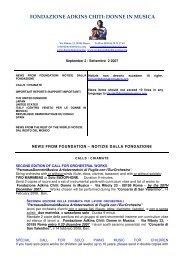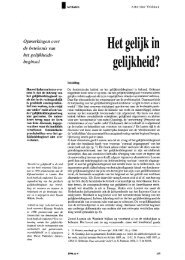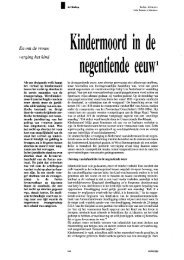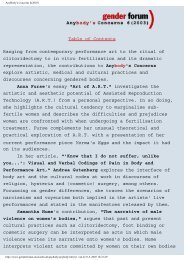Zeros and Ones - Aletta
Zeros and Ones - Aletta
Zeros and Ones - Aletta
Create successful ePaper yourself
Turn your PDF publications into a flip-book with our unique Google optimized e-Paper software.
Switch-A Report on Cyberfeminism<br />
A Report on Cyberfeminism<br />
Sadie Plant relative to VNS Matrix<br />
By: Alex Galloway<br />
"Hardware, software, wetware- -before their beginnings <strong>and</strong> beyond their ends, women<br />
have been the simulators, assemblers, <strong>and</strong> programmers of the digital machines."<br />
--Sadie Plant, <strong>Zeros</strong> <strong>and</strong> <strong>Ones</strong><br />
It would be hasty to dismiss Sadie Plant's recent book, <strong>Zeros</strong> <strong>and</strong> <strong>Ones</strong>, as being totally secondwave<br />
feminism. True, she seems quite interested in the deep, dark, technological feminine; she<br />
speaks of the male <strong>Ones</strong> <strong>and</strong> their binary opposites, the female <strong>Zeros</strong>; <strong>and</strong> she manages to weave<br />
together a genuine her-story of technology. Yet, she also reaches beyond these constrains into a<br />
complex relationship between women <strong>and</strong> machines. This relationship, tied up in problematics<br />
surrounding identity, technology <strong>and</strong> the body, is at the heart of the contemporary movement<br />
called cyberfeminism.<br />
Emerging from Adelaide, Australia in the early nineties, a group of artists <strong>and</strong> activists, calling<br />
themselves VNS Matrix, published the first Cyberfeminist Manifesto. From this early rant, the<br />
cyberfeminist movement began to grow <strong>and</strong> shift. It began to coalesce around Europe. And on<br />
September 20, 1997 in Kassel, Germany, the First Cyberfeminist International met at<br />
Documenta X, an international exhibition of contemporary art.<br />
Despite international recognition, cyberfeminism remains a highly problematic theoretical<br />
framework. No one is quite sure what it means. Its leaders, when they are not ab<strong>and</strong>oning the<br />
movement all together, have often given less than inspired readings of political <strong>and</strong><br />
technological issues. Because of this cyberfeminism remains a bit disappointing as avant-garde<br />
political movements go. There's no viable party line, strictly trade union consciousness.<br />
That said, the emerging cyber culture has certainly produced a need for cyberfeminism. Let's<br />
describe that need through the following set of questions: How does technology gender us?<br />
Does the internet escape discrimination through gender anonymity? Can technology help us<br />
overcome patriarchy? Why are computer geeks disproportionately male? Who wrote the history<br />
of computers? Are digital machines fundamentally male or female?<br />
http://switch.sjsu.edu/web/v4n1/alex.html (1 van 9)4/12/2005 12:11:01 PM
Switch-A Report on Cyberfeminism<br />
My goal is to give a report on the status of cyberfeminism today, to approach the subject of<br />
feminism <strong>and</strong> technology, in both its historical <strong>and</strong> ideological dimensions. As Faith Wilding<br />
<strong>and</strong> Critical Art Ensemble have noted in their recent study of cyberfeminism, "the territory of<br />
cyberfeminism is large. It includes the objective arenas [of] cyberspace, institutions of industrial<br />
design, <strong>and</strong> institutions of education--that is, those arenas in which technological process is<br />
gendered in a manner that excludes women from access to the empowering points of technoculture."<br />
Cyberfeminism in its very nature necessitates a decentered, multiple, participatory<br />
practice in which many lines of flight coexist.<br />
Part of the same movement that produced "girl power" e-zines like gURL <strong>and</strong> the now famous<br />
Geekgirl, the nineties cyberfeminist is a unique mixture of activist, cyberpunk, theorist <strong>and</strong><br />
artist. Historically, cyberfeminism has developed in two directions: the radical politics of Sadie<br />
Plant <strong>and</strong> VNS Matrix on the one h<strong>and</strong>, <strong>and</strong> the more mainstream work of the Old Boys<br />
Network (OBN is a mostly European consortium of cyberfeminists) <strong>and</strong> the FACES email<br />
community on the other (FACES, surprising enough for cyberspace, is a "women only" email<br />
list). Supplementing this are the various online publications that address the question of<br />
feminism <strong>and</strong> technology, including the new media art resource RHIZOME, the nettime<br />
community <strong>and</strong> the pop~TARTS web page, a feature section of Telepolis (a German-based<br />
online theory zine), which specializes in material on woman <strong>and</strong> technology. Cyberfeminist<br />
theory has also flourished in the print community with such recent books as Sadie Plant's <strong>Zeros</strong><br />
<strong>and</strong> <strong>Ones</strong> <strong>and</strong> S<strong>and</strong>y Stone's The War of Desire <strong>and</strong> Technology.... Although cyberfeminism has<br />
also benefited from the half-dozen or so anthologies emerging in recent years on digital studies-not<br />
the least of which are Timothy Druckrey's Electronic Culture, the Krokers' Digital Delirium<br />
<strong>and</strong> Lynn Hershman Leeson's Clicking In--much of this material remains male dominated,<br />
neglecting the scope <strong>and</strong> depth of contemporary cyberfeminism. Cyberfeminism's theoretical<br />
roots tend to grow out of an interesting mixture of Donna Haraway <strong>and</strong> French third-wave<br />
feminism <strong>and</strong> poststructuralism.<br />
The schism between the two halves of cyberfeminism has been exacerbated within the<br />
community on more than one occasion, including VNS Matrix member Francesca da Rimini's<br />
description of the current state of mainstream cyberfeminism as nothing more than some "quaint<br />
essentialist quilted rant." To their credit, the Old Boys Network (OBN) has been instrumental in<br />
bringing cyberfeminism into the institutional PGA Tour of cyberspace: the ISEAs, DEAFs, <strong>and</strong><br />
Ars Electronica festivals that run on <strong>and</strong> off throughout the year. Most spectacularly OBN was<br />
able to lead the so-called First Cyberfeminist International at last summer's Hybrid Workspace<br />
(a think tank for progressive politics <strong>and</strong> aesthetics at the recent Documenta X exhibition). That<br />
said, This paper is primarily addressed at what I believe to the more interesting faction of<br />
cyberfeminism, that of Plant, Stone <strong>and</strong> VNS Matrix.<br />
Sadie Plant <strong>and</strong> S<strong>and</strong>y Stone are perhaps the two best entry points into contemporary<br />
cyberfeminist theory. It is Plant's view that technology is fundamentally female--not male as the<br />
legions of geeks, computer science teachers, <strong>and</strong> Wired magazine editors would have us believe.<br />
Stone, on the other h<strong>and</strong>, focuses on how virtual communities produce things like bodies,<br />
identities <strong>and</strong> spaces.<br />
Plant, like French feminist Luce Irigaray before her, belongs to the recuperationist school of<br />
feminism. She argues that power structures, which have unequally favored men <strong>and</strong> male forms<br />
in society, should be made more equal through a process of revealing <strong>and</strong> valorizing overlooked<br />
female elements. The book turns on the story of Ada Lovelace, the world's first computer<br />
programmer. Ada's history is enthralling. As assistant to Charles Babbage, Lovelace helped<br />
http://switch.sjsu.edu/web/v4n1/alex.html (2 van 9)4/12/2005 12:11:01 PM
Switch-A Report on Cyberfeminism<br />
build early calculation machines such as the Babbage's Difference Engine. Clearly not enough is<br />
known about this figure <strong>and</strong> her interesting place in the development of computer society.<br />
Plant's goal is to recuperate this lost female origin from within the history of technology.<br />
However, as her manifesto-like "Feminisations: Reflections on Women <strong>and</strong> Virtual Reality"<br />
shows, Plant wishes not to valorize some negative space created by patriarchy, but to unveil the<br />
always already feminine space of technology. This is ultimately a more powerful move. Plant<br />
prophesizes that "Masculine identity has everything to lose from this new technics. The sperm<br />
count falls as the replicants stir <strong>and</strong> the meat learns how to learn for itself. Cybernetics is<br />
feminisation." Technology can give feminism something that it never had at its disposal, the<br />
obliteration of the masculine from beginning to end. With inspiration from the VNS Matrix <strong>and</strong><br />
their cyberfeminist manifesto, Plant starts to move toward defining the pure feminine.<br />
<strong>Zeros</strong> <strong>and</strong> <strong>Ones</strong> persuasively shows how women have always been inextricably involved with<br />
technology. Using the telephone operator as an example, she argues that women have<br />
traditionally comprised the laboring core of networks of all kinds, particularly the telephone<br />
system. From the power loom to typewriting, even to the discovery of computer "bugs," Plant<br />
categorizes technology as a fundamentally female object. She argues that women are intelligent<br />
machines, that the robotic is feminine, that the zero--the nothingness of binary code--has always<br />
been the 0-ther, the female.<br />
On the writing of <strong>Zeros</strong> <strong>and</strong> <strong>Ones</strong>, Plant remembers: "when I started the book it was really to try<br />
<strong>and</strong> correct, what I thought was the great miss-conception at the moment about the relationship<br />
between women <strong>and</strong> computers in particular <strong>and</strong> technology in general. It seemed to me, that a<br />
lot of 'orthodox' feminist theory was still very technophobic."<br />
Throughout her work the matrix is a primary metaphor. This materializes itself historically in<br />
the weaving processes of industrial power looms, in the predominantly female telephone<br />
operators, in the trope of the woman as computer programmer (Ada Lovelace, Grace Murray<br />
Hopper) <strong>and</strong> in the web-like structure of cyberspace. Because of this history, Plant writes that<br />
technology is fundamentally a process of emasculation. "The matrix weaves itself in a future<br />
which has no place for historical man," says Plant. If technology is essentially feminine, then the<br />
women is the computer. Or rather, like the Turing machine (a machine that can be any machine),<br />
women can imitate the computer. Women are the ultimate mimetic force. Plant writes, "Women<br />
cannot be anything, but she can imitate anything valued by man: intelligence, autonomy,<br />
beauty...perhaps the very possibility of mimesis." The imitating force is strengthened by the<br />
emergence of the digital as a powerful semiovic network. The digital provides a space of<br />
valences that exists outside of <strong>and</strong> potentially preempts patriarchal structures. As Plant describes<br />
it, "the introduction of binary code introduces a plane of equivalence which undermines the very<br />
foundations of a world in which male <strong>and</strong> female have played the roles of superstructure <strong>and</strong><br />
material base." In this model binary code replaces what have traditionally been the producers of<br />
value, these being the phallus, the law, the father, etc. In Plant, technology is less a question of<br />
good or <strong>and</strong> more the possibility for an objective weakening of patriarchy. "Cyberfe minism to<br />
me implies [that] an alliance is being developed between women, machinery <strong>and</strong> the new<br />
technology that women are using."<br />
Held aloft, yet notabl{ aloof from the cyberfeminist movement is Allucquère Rosanne (S<strong>and</strong>y)<br />
Stone, transgendered theorist of the history of cyberspace, desire <strong>and</strong> the virtual body. Stone's<br />
early essay "Will the Real Body Please St<strong>and</strong> Up?" helped set the stakes for contemporary<br />
debates on the status of the body in virtual communities. The place of the body is central to<br />
cyberfeminism. Stone argues persuasively that binarisms such as nature/culture actually function<br />
http://switch.sjsu.edu/web/v4n1/alex.html (3 van 9)4/12/2005 12:11:01 PM
Switch-A Report on Cyberfeminism<br />
logically as "a strategy for maintaining boundaries for political <strong>and</strong> economic ends, <strong>and</strong> thus a<br />
way of making meaning." The insertion of the body into virtual space actually produces<br />
meaning through the articulation of differences between bodies <strong>and</strong> non-bodies, between spaces<br />
<strong>and</strong> non-spaces. Like Foucault's rejection of the "repressive hypothosis," Stone claims that new<br />
technologies are not transparent agents that remove issues of gender from view, but rather they<br />
proliferate the production <strong>and</strong> organization of gendered bodies in space. She shows that the<br />
dominant spatial metaphor (what Doreen Massey might call an "imaginary geography") for<br />
interactions in virtual spaces is, simply enough, the metaphor of our daily physical, Cartesian<br />
space. And like our offline space, virtual spaces are inhabited by bodies with "complex erotic<br />
components." This working metaphor is, of course, totally arbitrary as Stone points out, since<br />
there is nothing in the logic of digital networks that necessarily prestructures itself as Cartesian,<br />
or body-based, or desiring. So then, why are online communities so based on desire, space <strong>and</strong><br />
bodies? This is the cyberfeminist question for Stone.<br />
Sherry Turkle echoes this sentiment in her "Constructions <strong>and</strong> Reconstructions of the Self in<br />
Virtual Reality." For Turkle digital technologies focus heavily on the question of identity. Like<br />
Stone, Turkle describes what happens in online communities, spaces where role playing <strong>and</strong><br />
genderbending are par for the course.<br />
Virtual space, then, is imagined as a prosthesis, as an enormous extension of our physical<br />
bodies. Through this giant phantom limb (the net) we must, of course, interact. Stone shows that<br />
communications technology is conventionally thought of as "1) an apparatus for the production<br />
of community... 2) an apparatus for the production of body... [<strong>and</strong>] 3) a mediating [agent]<br />
between bodies <strong>and</strong> selves...i.e., interfaces." Community, body, interface--an unlikely offspring<br />
of binary code! Most fundamentally, participants in online communities like the object-oriented<br />
social spaces called MOOs "learn to delegate their agencies to body representatives that exist in<br />
imaginal spaces contiguously with representatives of other individuals." The creators of one of<br />
the most popular MOOs, LambdaMOO, describe this relationship of bodies in social terms:<br />
"LambdaMOO is a new kind of society, where thous<strong>and</strong>s of people voluntarily come together<br />
from all over the world." As Stone <strong>and</strong> others show, a participatory social practice (i.e.<br />
community) based on an imagined ether-scape of desiring <strong>and</strong> interacting bodies is basic to how<br />
we conceptualize digital spaces.<br />
Cyberfeminist pioneers VNS (VeNuS) Matrix provided the front line guerrilla tactics for Stone<br />
<strong>and</strong> Plant's theoretical efforts. VNS Matrix emerged from Adelaide, Australia, in the summer of<br />
1991. Francesca da Rimini (also known as Gashgirl <strong>and</strong>/or Doll Yoko) gives her story of how it<br />
all started:<br />
"Like all good coagulating stories it starts with slime, <strong>and</strong> maybe ends with<br />
blood. I live on the edge of the Australian desert in a small town of lies <strong>and</strong><br />
whispers with a palpable palpitating underbelly... It was the summer of 91.<br />
Definitely not the summer of love. We were four girls. We were hot <strong>and</strong> bored<br />
<strong>and</strong> poor (for me not much has changed, except I am no longer bored). We<br />
decided to try <strong>and</strong> crack the porn cartel with some chick porn. We made some<br />
images on stolen computers, Beg, Bitch, Fallen, Snatch. We decided it was more<br />
fun playing with computers than endlessly scanning our pussies <strong>and</strong> so Velvet<br />
Downunder morphed into VNS Matrix. Tagging ourselves the virus of the new<br />
world disorder <strong>and</strong> fuelled by red wine <strong>and</strong> g-slime (which could only be<br />
replenished by engaging frequently in pleasurable distractions)."<br />
http://switch.sjsu.edu/web/v4n1/alex.html (4 van 9)4/12/2005 12:11:01 PM
Switch-A Report on Cyberfeminism<br />
VNS Matrix were Josephine Starrs, Julianne Pierce, Francesca da Rimini <strong>and</strong> Virginia Barratt.<br />
They have perpetrated a series of cyberfeminist interventions including a "bad code" anti-video<br />
game targetted at girls (or at least not targetted at 14 year-old boys) <strong>and</strong> featuring characters<br />
such as "Big Daddy Mainframe." Da Rimini (as Doll Yoko) writes, "cyberfeminism/s has<br />
become the field from which i work, from which multiple lines of flight errupt anarchically,<br />
generating dialogues, relations, conceptual <strong>and</strong> physical objects."<br />
To appreciate the full force of the VNS Matrix cyberfeminist manifesto, it is worth including in<br />
its original form:<br />
Their slogan "the clitoris is a direct line to the matrix" immediately jumps out of this<br />
provocative rant. It is meant to highlight a fundamental material coexistence between the<br />
machine <strong>and</strong> the female body. Originally ignorant of the work of Sadie Plant VNS Matrix built<br />
their own theory-based activism centered around women <strong>and</strong> technology. Julianne Pierce notes,<br />
"at the same time as we started using the concept of cyberfeminism, it also began to appear in<br />
other parts of the world. It was like a spontaneous meme which emerged at around the same<br />
time, as a response to ideas like 'cyberpunk' which were popular at the time. Since then the<br />
meme has spread rapidly <strong>and</strong> is certainly an idea which has been embraced by many women<br />
who are engaged with techno theory <strong>and</strong> practice." Pierce notes that cyberfeminists have never<br />
been anti-technology, rather they adore machines <strong>and</strong> use them integrally in their political<br />
action, art <strong>and</strong> writing.<br />
In what produced a temporary antagonism between the nettime feminists <strong>and</strong> their more radical<br />
fringe, da Rimini (writing as Doll Yoko) posted in June, 1997 to the nettime list that "as artists,<br />
[VNS Matrix] were serious bout usin strategies like irony 'n inversion of cultural stereotypes to<br />
raise some of the many issues around women <strong>and</strong> technology .. access .. education .. jobs ..<br />
portrayal of girls/chix/women in popular/games culture etc etc." Da Rimini's sentiment is typical<br />
of the VNS Matrix br<strong>and</strong> of cyberfeminism, a crude, confrontational liberationist politics for<br />
women in the digital matrix.<br />
Throughout all of cyberfeminist theory the theme of bodies <strong>and</strong> identities dominates. As one<br />
http://switch.sjsu.edu/web/v4n1/alex.html (5 van 9)4/12/2005 12:11:01 PM
Switch-A Report on Cyberfeminism<br />
critic notes, "Bodies generally are all the rage on the Net--whether they are obsolete, cyborg,<br />
techno, porno, erotic, morphed, recombined, phantom, or viral." Indeed, much of the focus on<br />
bodies steams from the process of forgetting the body or trying to forget about forgetting the<br />
body. As Stone <strong>and</strong> others have written, the advent of cyberspace is the story of bodies<br />
migrating <strong>and</strong> morphing into new contexts. In fact, Lynn Hershman Leeson goes so far as to<br />
claim that "new [web] users are forming the largest immigration in history"--a powerful idea to<br />
keep in mind, that computer use could possibility constitute a real immigration of bodies from<br />
the offline to the online.<br />
Another interest of the cyberfeminists, the "posthuman" body is the focus of TechnoMorphica, a<br />
recent book of art <strong>and</strong> essays from the Dutch V2_Organisation. Unlike Donna Haraway's early<br />
work on bio/techno hybrids, TechnoMorphica benefits from contemporary developments in<br />
areas such as augmented reality, nanotechnology <strong>and</strong> prosthetics to arrive at a more shockingly<br />
immediate description of the future of art <strong>and</strong> the future of theory. If this intriguing anthology<br />
must have a theme, it would be the "new cyborg," the rearrangement of the organic world<br />
around the model of the intelligent machine. The well developed transformation of machines<br />
into organisms <strong>and</strong> organisms into machines is the model for the new cyborg. Amazingly, the<br />
book includes a 180 page, full color, frame-by-frame photo documentation of Australian artist<br />
Stelarc's "Stomach Sculpture," a swallowed video probe exploration of the inside of the artist's<br />
digestive track. Says Stelarc, "the body has been augmented, invaded <strong>and</strong> now becomes a host-not<br />
only for technology, but also for remote agents." He elaborates on the "Stomach Sculpture"<br />
in a recent CTHEORY interview: "with the stomach sculpture, I position an artwork inside the<br />
body. The hollow body becomes a host, not for a self or a soul, but simply for a sculpture."<br />
Another piece that uses video footage of the inside of the body is Mona Hatoum's "Corps<br />
Etranger." Hatoum creates a haunting audio/visual space using video footage from a micro-sized<br />
video camera traveling down the esophagus <strong>and</strong> into the stomach. The footage is then staged<br />
within a larger immersive installation booth that includes a soundtrack of the artist breathing.<br />
Hatoum's interest in the immersive environment plays itself twice over: the user is plunged into<br />
the viewing booth, then plunged down into a sickening biological space lit up only by the techo<br />
eye. The body is at once reviled <strong>and</strong> revealed.<br />
In the same way cyberfeminism aims to exorcise the essentialized female body through a<br />
complex process of revalorization <strong>and</strong> rebuilding. The Cartesian subject is irrelevant here, as<br />
Plant explains: "Basically the two positions that are established at the minute are either that you<br />
talk about disembodiment or you talk about embodiment. Either you're out of the body in some<br />
stratospheric zone or you're in the organism. I think that neither of those are correct. When<br />
people talk about getting out of the body they are still assuming that there is some kind of great<br />
transcendent space like heaven for the soul, or something non-material at any rate, to occupy.<br />
And as far as I'm concerned that isn't there. The universe isn't like that, it's a material process not<br />
some sort of idealist construction. So you can't get out of matter, that's the crucial thing. But you<br />
can get out of the confining organization of matter which is shaped into things <strong>and</strong> of course,<br />
organisms. The organism is literally organized around its organs, the vocabulary says it all<br />
really."<br />
Contemporary cyberfeminist art, including VNS Matrix's self-described "cunt art," follows<br />
Plant's guideline to the letter. Like Fluxus artist Shigeko Kubota's performance "Vagina<br />
Painting," VNS Matrix focused on a raw, fleshy, expressive use of the body. Other<br />
cyberfeminist, technology-based art includes Eva Grubinger's "Netzbikini." The Netzbikini<br />
project parodies the act of buying a bikini, by offering bikini patterns that one can download<br />
from the internet <strong>and</strong> sew together out of "sheer, transparent net fabric." The project turns<br />
http://switch.sjsu.edu/web/v4n1/alex.html (6 van 9)4/12/2005 12:11:01 PM
Switch-A Report on Cyberfeminism<br />
interactive as users are invited to submit photos of themselves in their new bikinis. The photos<br />
are exhibited on the Netzbikini site. Nancy Paterson goes in a different direction on the question<br />
of the body. Her "Stock Market Skirt" is composed of a blue taffeta <strong>and</strong> black velvet party dress,<br />
a computer <strong>and</strong> a stock market ticker. The dress is connected to the computer, which with the<br />
help of a robotic device is able to raise or lower the length of the skirt. As the stock market rises<br />
<strong>and</strong> falls, the computer reads the market prices <strong>and</strong> varies the length of the skirt accordingly.<br />
These two pieces show the various ways cyberfeminist art has considered the body.<br />
Following close behind the question of the body is the question of identity. The question of<br />
identity is always a delicate balance between a desire to critique essentialism <strong>and</strong> a desire to<br />
remain politically committed. Although not connected to digital studies, Elspeth Probyn, in her<br />
Outside Belongings is one person who has tried to define a theory of identity after<br />
antihumanism. There is thus a natural affinity with her work <strong>and</strong> the goals of cyberfeminism.<br />
Probyn writes, "I want to figure the desire that individuals have to belong, a tenacious <strong>and</strong><br />
fragile desire that is, I think, increasingly performed in the knowledge of the impossibility of<br />
ever really <strong>and</strong> truly belonging, along with the fear that the stability of belonging <strong>and</strong> the<br />
sanctity of belongings are forever past." Probyn's longing, then, is to navigate a theory of<br />
practices--a theory of living--having already digested a steady diet of antihumanist rhetoric a la<br />
psychoanalysis <strong>and</strong> poststructuralism. The word "performed" reminds us of Butler whose<br />
original Gender Trouble was itself a struggle with questions of identity. Unfortunately Probyn's<br />
navigation of the unknown space after humanism leaves much to be desired. The exciting early<br />
convocations of Foucault, hints of a radically singular psychogeography of the self, an aspiration<br />
to perform a "sociology of the skin," the mention of Stuart Hall's concept of articulation,<br />
Deleuze's rhizomatics--all these ill prepare the reader for Probyn's lapse into analyses of the<br />
"richness" of her childhood, her mother's "passion for horses" <strong>and</strong> other autobiographical<br />
absurdities. An informal style not dissimilar to Stone, Probyn's first person narration would<br />
profit from a higher level of objective-ness, more new novel <strong>and</strong> less memoir. In the end, I say<br />
to Probyn's "longing" what Foucault says to Deleuze's "desire": "I cannot st<strong>and</strong> the word desire;<br />
even if you use it differently, I can't help myself thinking or living desire = lack, or that desire<br />
says repression." Can we use the master's tools?<br />
In the case of Butler, feminism <strong>and</strong> the question of identity are distinctly poststructuralist.<br />
Because of this she participates in a critique of humanist theories of subjectivity <strong>and</strong> social space<br />
more suited to the cyberfeminist project. In Gender Trouble she has yet to consider the "after" of<br />
humanism that is in Probyn, only a critique of what she calls alternately "ontological<br />
constuctions of identity," "gender ontologies" <strong>and</strong> "metaphysics of substance," in short,<br />
humanist metaphysics. And well done too. Butler deftly navigates through the Scylla <strong>and</strong><br />
Charybdis of the theoretical left: avoid essentialism, maintain the political agent. As Butler<br />
queries, "what sense can we make of a construction that cannot assume a human constructor<br />
prior to that construction?" Butler, then, rooted in a deep materialism, posits a human subject<br />
that is both constituted by <strong>and</strong> constitutive of his/her social environment. Butler's affection for<br />
Derrida shines through clearly in this text as her marxist logics take on a decidedly<br />
poststructuralist flair: "Gender is a complexity whose totality is permanently deferred, never<br />
fully what it is at any given juncture in time. An open coalition, then...will be an open<br />
assemblage that permits of multiple convergences <strong>and</strong> divergences without obedience to a<br />
normative telos of definitional closure."<br />
Like Probyn <strong>and</strong> unlike Butler, the cyberfeminism of Plant, Stone <strong>and</strong> VNS Matrix seems at<br />
times to be experimenting with the post-gender, not merely a critique of gender. The potentiality<br />
of the posthuman (artificial life, prosthetics, viruses, cyborgs, etc.), something only available<br />
http://switch.sjsu.edu/web/v4n1/alex.html (7 van 9)4/12/2005 12:11:01 PM
Switch-A Report on Cyberfeminism<br />
with the advent of technology, is instrumental here. Haraway's prescient claim that "the cyborg<br />
is a creature in a post-gender world" might easily be turned around to fit the needs of the<br />
cyberfeminists, that the cyberfeminist is a post-gender creature in a virtual world.<br />
But is this post-gender world possible? And do we really want it? Catherine Richards highlights<br />
a curious potential fate for cyberfeminism: will cyberfeminism become nothing but ironic<br />
nostalgia for past difference, that is, if we are ever truly post-gender will we only be able to wax<br />
poetic on the state of struggle in the gendered past? Asks Richards, "if something about<br />
contemporary virtual technology erases gender as articulated, will radical cyber-feminism be<br />
consigned to nostalgic content as much as traditional lonely male heroism?" Plant, Stone <strong>and</strong> the<br />
VNS Matrix are our best allies for navigating these difficult questions.<br />
+ + +<br />
Fragments of this text first appeared in my review of Plant's <strong>Zeros</strong> <strong>and</strong> <strong>Ones</strong>, published at the<br />
Thing Reviews.<br />
1 Sadie Plant, "Feminisations: Reflections on Women <strong>and</strong> Virtual Reality," in Lynn Hershman<br />
Leeson, Ed. Clicking In (Bay Press, 1996), p. 37.<br />
2 Sadie Plant, "The Future Looms: Weaving Women <strong>and</strong> Cybernetics," in Lynn Hershman<br />
Leeson, Ed. Clicking In (Bay Press, 1996), p. 132.<br />
3 Ibid.<br />
4 Allucquère Rosanne Stone, "Will the Real Body Please St<strong>and</strong> Up?" in Michael Benedikt, Ed.<br />
Cyberspace. First Steps (MIT Press, 1992).<br />
5 Stone, "Will the Real Body Please St<strong>and</strong> Up?" p. 102.<br />
6 Ibid, p. 105.<br />
7 Sherry Turkle, "Constructions <strong>and</strong> Reconstructions of the Self in Virtual Reality," in Timothy<br />
Druckrey, Ed. Electronic Culture (Aperture, 1996), pp. 354-365.<br />
8 Allucquère Rosanne Stone, The War of Desire <strong>and</strong> Technology at the Close of the Machine<br />
Age (MIT Press, 1995). p. 89.<br />
9 Ibid, p. 121.<br />
10 Lynn Hershman Leeson, "Romancing the Anti-Body: Lust <strong>and</strong> Longing in (Cyber)space" in<br />
Lynn Hershman Leeson, Ed. Clicking In (Bay Press, 1996), p. 328.<br />
11 Joke Brouwer <strong>and</strong> Carla Hoekendijk, Eds. TechnoMorphica (V2_Organisation, 1997), p. 15.<br />
12 Elspeth Probyn, Outside Belongings (Routledge, 1996), p. 8.<br />
13 Cited in Probyn, Outside Belongings, p. 47.<br />
14 Judith Butler, Gender Trouble (Routledge, 1990), pp. 5, 33, 25.<br />
15 Butler, Gender Trouble, p. 8.<br />
16 Ibid, p. 16, emphasis mine.<br />
17 Donna Haraway, Simians, Cyborgs, <strong>and</strong> Women (Routledge, 1991), p. 150.<br />
18 Catherine Richards, "Fungal Intimacy: The Cyborg in Feminism <strong>and</strong> Media Art" in Lynn<br />
Hershman Leeson, Ed. Clicking In (Bay Press, 1996), p. 261.<br />
Back to top<br />
Table of Contents<br />
http://switch.sjsu.edu/web/v4n1/alex.html (8 van 9)4/12/2005 12:11:01 PM
Switch-A Report on Cyberfeminism<br />
San Jose<br />
State<br />
University<br />
Information about CADRE<br />
graduate <strong>and</strong> undergraduate<br />
programs<br />
http://switch.sjsu.edu/web/v4n1/alex.html (9 van 9)4/12/2005 12:11:01 PM













